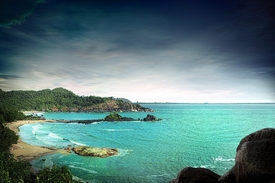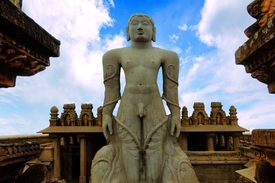Art Forms
The art of story-telling comes from passion and creativity. It is embedded within and it is portrayed so naturally and beautifully. Be it drama, dance, music or storytelling, you can witness vivid diversity in terms of cultural dress, traditional dance forms, social and cultural history and so on.
Yaskhagana is a classic folk play that falls under the theatrical art forms of coastal Karnataka. There are totally 12 art forms of which Yakshagana is undisputedly the poster-child of the art forms, it’s lesser known counterparts are equally enthralling in their own way.
Gamaka is a unique music form based on Karnataka Sangeetha while other dance forms like Boodkali (Coorg), Dasaratha (North Karnataka) seem to have lost their value over the years. Dance forms like Veeragase and Kamsale portray the culture of Karnataka and Dollu Kunitha is a special dance form that makes use of colored drums, performed by male shepherds of the Kuruba community making it looking vibrant and lively.
The names of certain dance forms, Devare Thatte Kunitha, Yellammana Kunitha, Sugi Kunitha, to name a few, are derived from either the deity they worship or a symbol or the instruments they use. Apart from the above, Karnataka embraces the most distinguished classical dance form of India, Bharathnatyam and others such as Kuchipudi and Kathak.
Yakshagana
The “celestial song” or ‘Yakshagana’ is the most enchanting amalgamation of dance, music and literature. This traditional theatre form with a history of over 400 years is known for it extemporaneous dialogue delivery. Bhagavatha, the main storyteller accompanies a group of musicians – ‘chande’ and ‘mavdale’, as they weave mythological stories helped by hued costumes and dynamic dance forms.
Dollu Kunita
The Dollu Kunita is a powerful drum dance accompanied by acrobatic movements, synchronized group formations and the occasional screams. The shepherd community of Kurubas performs the dance to honour their deity, Beereshwara, a form of the Hindu god, Shiva. A major attraction for any religious festivals in villages, about a dozen artistes move with vigour to the rich vibrations of the Dollu or the drum.
Beesu Kamsale
Beesu Kamsale is a vigorous dance form closely associated with the rituals of Malle Mahadeswara worship and employs a great blend of aesthetic sublimity and martial agility. A cymbal-like disc, the ‘Kamsale’ is played in rhythm with the songs exalting the glory of the Lord Mahadeswara.
Somana Kunita
Somana Kunita is a religious, ritualistic dance performed by two or three artists with elaborate masks. Known as Somas, they were entrusted with the task of guarding the village deities and also worshipping them. The stories related to the birth of the Somas forms the crux of the performance.
Krishna Parijata
This traditional folk theater form revolves around Lord Krishna, and his fight with Indira over the Parijatha tree. Known for their frequent witticisms, they are mostly open-air performances. Simple plots and dialogues, spontaneity of the performers and impromptu improvisations make Krishna Parijata a great attraction to the audiences.
Chowdike Mela
The devotees of Yellama, the patron goddess of the rural folk of North Karnataka, perform Chowdike Mela. ‘Chowdike’, a unique stringed instrument, partners their mesmerizing praise of the Goddess. The singers usually dedicate their entire lives solely to singing the heavenly glory.
Goravara Kunita
This religious dance is performed by the devotees of Shiva, the Hindu God. Attired in fur cap made of bearskin and black and yellow clothing, they sway to the esoteric tunes of the flute and the ‘Damaruga’, a hand-held drum. Accompanying their trance-like movements, are songs handed down through generations, replete with deep mystic meanings.
Veeragaase
Veeragase gets its name from the Hindu legendary warrior, Veerabhadra, where dancers narrate the story of Daksha Yajna. Attired in colourful garb and traditional headgear, the dancers carry a wooden plaque of Veerabhadra in their left hand and a sword in their right. The dance sometimes involves a ritualistic piercing of a needle across the tongue.
Puja Kunita
Puja Kunita is the dance of worship performed to propitiate the Goddess Shakti. The dancer carries a five feet frame made out of bamboo called Puje, wrapped with beautiful saris and flowers, during the performance. Devoid of any stories, the dancers provide visual exclusivity by their acrobatic movements.
Ummattaattu
Ummaattaattu is the traditional dance form of Coorg made famous by the beautiful Kodava women. Adorned in the traditional red brocade Sari, jewellery and red vermilion on the forehead, they dance in circles to the rhythms of hand-held brass cymbals. Accompanied by singing, the dance form – performed to appease Goddess Cauvery – is usually part of festivals, weddings, etc.
Jagghalige Kunita
A large percussion instrument made from the wheels of a bullock cart, wrapped with buffalo hides called ‘Jagghalige’ is largely used in this folk art. Usually involving about 15 people, the dancers march to the pulsating beat of the giant drums. Jagghalige Kunita is performed during festivals like Ugadi and Holi.
Suggi Kunita
A Harvest festival dance, Suggi Kunita is performed mostly by the farming community. Artists in beautiful costumes and wooden headgear adorned with carved birds and flowers dance to the tune of drums with sticks and peacock feathers. They enhance the dance sometimes, by their own signing.




